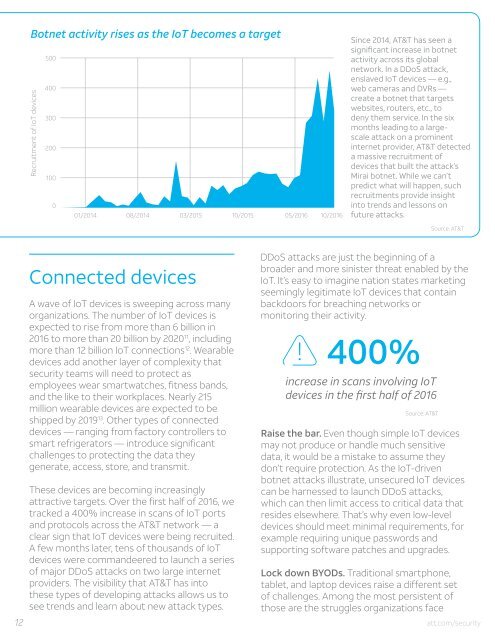The CEO’s Guide to Data Security
2mRmvHx
2mRmvHx
You also want an ePaper? Increase the reach of your titles
YUMPU automatically turns print PDFs into web optimized ePapers that Google loves.
Botnet activity rises as the IoT becomes a target<br />
Recruitment of IoT devices<br />
500<br />
400<br />
300<br />
200<br />
100<br />
0<br />
01/2014 08/2014 03/2015 10/2015 05/2016 10/2016<br />
Since 2014, AT&T has seen a<br />
significant increase in botnet<br />
activity across its global<br />
network. In a DDoS attack,<br />
enslaved IoT devices — e.g.,<br />
web cameras and DVRs —<br />
create a botnet that targets<br />
websites, routers, etc., <strong>to</strong><br />
deny them service. In the six<br />
months leading <strong>to</strong> a largescale<br />
attack on a prominent<br />
internet provider, AT&T detected<br />
a massive recruitment of<br />
devices that built the attack’s<br />
Mirai botnet. While we can’t<br />
predict what will happen, such<br />
recruitments provide insight<br />
in<strong>to</strong> trends and lessons on<br />
future attacks.<br />
Source: AT&T<br />
12<br />
Connected devices<br />
A wave of IoT devices is sweeping across many<br />
organizations. <strong>The</strong> number of IoT devices is<br />
expected <strong>to</strong> rise from more than 6 billion in<br />
2016 <strong>to</strong> more than 20 billion by 2020 11 , including<br />
more than 12 billion IoT connections 12 . Wearable<br />
devices add another layer of complexity that<br />
security teams will need <strong>to</strong> protect as<br />
employees wear smartwatches, fitness bands,<br />
and the like <strong>to</strong> their workplaces. Nearly 215<br />
million wearable devices are expected <strong>to</strong> be<br />
shipped by 2019 13 . Other types of connected<br />
devices — ranging from fac<strong>to</strong>ry controllers <strong>to</strong><br />
smart refrigera<strong>to</strong>rs — introduce significant<br />
challenges <strong>to</strong> protecting the data they<br />
generate, access, s<strong>to</strong>re, and transmit.<br />
<strong>The</strong>se devices are becoming increasingly<br />
attractive targets. Over the first half of 2016, we<br />
tracked a 400% increase in scans of IoT ports<br />
and pro<strong>to</strong>cols across the AT&T network — a<br />
clear sign that IoT devices were being recruited.<br />
A few months later, tens of thousands of IoT<br />
devices were commandeered <strong>to</strong> launch a series<br />
of major DDoS attacks on two large internet<br />
providers. <strong>The</strong> visibility that AT&T has in<strong>to</strong><br />
these types of developing attacks allows us <strong>to</strong><br />
see trends and learn about new attack types.<br />
DDoS attacks are just the beginning of a<br />
broader and more sinister threat enabled by the<br />
IoT. It’s easy <strong>to</strong> imagine nation states marketing<br />
seemingly legitimate IoT devices that contain<br />
backdoors for breaching networks or<br />
moni<strong>to</strong>ring their activity.<br />
400%<br />
increase in scans involving IoT<br />
devices in the first half of 2016<br />
Source: AT&T<br />
Raise the bar. Even though simple IoT devices<br />
may not produce or handle much sensitive<br />
data, it would be a mistake <strong>to</strong> assume they<br />
don’t require protection. As the IoT-driven<br />
botnet attacks illustrate, unsecured IoT devices<br />
can be harnessed <strong>to</strong> launch DDoS attacks,<br />
which can then limit access <strong>to</strong> critical data that<br />
resides elsewhere. That’s why even low-level<br />
devices should meet minimal requirements, for<br />
example requiring unique passwords and<br />
supporting software patches and upgrades.<br />
Lock down BYODs. Traditional smartphone,<br />
tablet, and lap<strong>to</strong>p devices raise a different set<br />
of challenges. Among the most persistent of<br />
those are the struggles organizations face<br />
att.com/security



